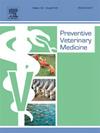Knowledge, attitude and practices of primary livestock raisers regarding anthrax and anthrax vaccination of livestock in outbreak and non-outbreak areas of Bangladesh
IF 2.4
2区 农林科学
Q1 VETERINARY SCIENCES
引用次数: 0
Abstract
Anthrax is a zoonotic disease caused by the spore-forming bacterium Bacillus anthracis. Outbreaks are periodically reported among people and livestock in Bangladesh. From 2009–2020, approximately 4000 suspected human cutaneous anthrax cases were reported. Although annual livestock vaccination against anthrax is one of the primary control methods, we do not know the livestock vaccination practices in Bangladesh. We aimed to determine the knowledge, attitude, and practices of livestock raisers regarding the use of anthrax vaccination. We conducted a cross-sectional survey in four districts with the highest number of suspected human anthrax cases and four districts having no reported cases from October 2017 to March 2018. We randomly selected 81 villages in total; 10–11 villages per district. From each village, 20 households with at least one domestic animal (cattle/buffalo/goat/sheep) were randomly enrolled and the primary livestock raisers were interviewed. Among the 1620 livestock raisers, 36 % had heard of the livestock disease “anthrax” or “Torka” (the local name); 48 % from outbreak districts and 24 % from non-outbreak districts (p < 0.001). Only 11 % of total respondents were aware that anthrax caused human disease. Overall, 25 % of respondents reported vaccinating their livestock for any disease. Among those, only 18 % reported vaccinating against anthrax. Most (73 %) of the livestock raisers who did not vaccinate their animals reported they were unaware of the vaccine against anthrax. Livestock raisers reported being willing to pay an average of 0.12 USD per vaccine for cattle/buffalo, and 0.06 USD for goats/sheep. Although the reported use of livestock vaccination was low in outbreak districts, respondents were more likely to be aware of anthrax. These findings highlight a need for community engagement with targeted education, and risk communication for livestock raisers regarding knowledge of anthrax, the importance of vaccination, and increasing the accessibility of anthrax vaccine in endemic villages.
孟加拉国爆发和非爆发地区主要牲畜饲养者关于炭疽和牲畜炭疽疫苗接种的知识、态度和做法
炭疽是一种由芽孢杆菌引起的人畜共患疾病。孟加拉国定期报告在人群和牲畜中暴发疫情。从2009年至2020年,报告了大约4000例疑似人类皮肤炭疽病例。虽然每年为牲畜接种炭疽疫苗是主要的控制方法之一,但我们不了解孟加拉国的牲畜接种做法。我们的目的是确定知识,态度和做法的牲畜饲养有关使用炭疽疫苗接种。我们在2017年10月至2018年3月期间对4个疑似人类炭疽病例最多的地区和4个未报告病例的地区进行了横断面调查。随机抽取81个村庄;每个区10-11个村庄。从每个村庄随机招募至少有一只家畜(牛/水牛/山羊/绵羊)的20户家庭,并对主要家畜饲养者进行访谈。在1620名家畜饲养者中,36% %听说过家畜疾病“炭疽”或“托尔卡”(当地名称);48 %来自爆发区,24 %来自非爆发区(p <; 0.001)。只有11% 答复者知道炭疽引起人类疾病。总体而言,25% %的答复者报告他们的牲畜接种了任何疾病的疫苗。在这些人中,只有18% %报告接种了炭疽疫苗。大多数(73% %)没有给牲畜接种疫苗的牲畜饲养者报告说,他们不知道有炭疽疫苗。牲畜饲养者报告说,他们愿意为每只牛/水牛平均支付0.12美元,为山羊/绵羊平均支付0.06美元。尽管在疫情暴发地区报告的牲畜疫苗接种使用率很低,但应答者更有可能了解炭疽。这些发现突出表明,需要社区参与,开展有针对性的教育,并就炭疽知识、疫苗接种的重要性以及在流行村庄增加炭疽疫苗的可及性对牲畜饲养者进行风险沟通。
本文章由计算机程序翻译,如有差异,请以英文原文为准。
求助全文
约1分钟内获得全文
求助全文
来源期刊

Preventive veterinary medicine
农林科学-兽医学
CiteScore
5.60
自引率
7.70%
发文量
184
审稿时长
3 months
期刊介绍:
Preventive Veterinary Medicine is one of the leading international resources for scientific reports on animal health programs and preventive veterinary medicine. The journal follows the guidelines for standardizing and strengthening the reporting of biomedical research which are available from the CONSORT, MOOSE, PRISMA, REFLECT, STARD, and STROBE statements. The journal focuses on:
Epidemiology of health events relevant to domestic and wild animals;
Economic impacts of epidemic and endemic animal and zoonotic diseases;
Latest methods and approaches in veterinary epidemiology;
Disease and infection control or eradication measures;
The "One Health" concept and the relationships between veterinary medicine, human health, animal-production systems, and the environment;
Development of new techniques in surveillance systems and diagnosis;
Evaluation and control of diseases in animal populations.
 求助内容:
求助内容: 应助结果提醒方式:
应助结果提醒方式:


